Ognjena Marija (Ogniowa Maryja)
źródło: Old European Culture © © tłumaczenie i komentarz Czesław Białczyński
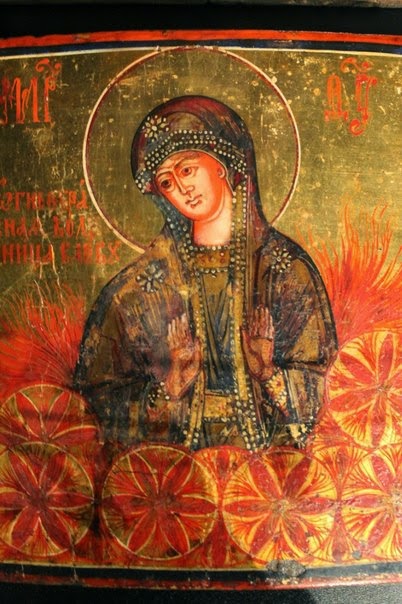
Perperuna – Ogniowa Maryja – ikona
In my post about stone circles on mountaing Devica, i mentioned the solar observatory called Bogovo Gumno. I would like to continue talking about this stone circle complex and explain why it is so significant.
W moim poście o kamiennych kręgach na górze Devica wspomniałem o obserwatorium słonecznym Bogovo Gumno. Chciałbym kontynuować rozmowę o tym kompleksie kamiennych kręgów i wyjaśnić, dlaczego jest on tak znaczący.
The most important thing about Bogovo Gumno complex is not that it is a group of stone circles aligned with the summer solstice and used for determining the beginning of the solar calendar. Many other stone circles in Europe were built for the same purpose, although admittedly few are as big as Bogovo Gumno circles. The most important thing about Bogovo Gumno complex is that it gives us proof that a stone circle originally built as a solar observatory in an unknown distant past, was still recognized as a holy place and an astronomical observatory and was used as such by the local peasant population until the end of the 19th and the the beginning of the 20th century.
Remember what I said about rondel enclosures.
When you read about central European rondel enclosures, you are always told that
But, by contrast to the long lifetime of the „Megalithic” culture, the time window during which the neolithic ”Roundels” were in use is surprisingly narrow, lasting only for about 200–300 years (roughly 49th to 47th centuries BC).
How is this usage period determined? It seems that what people mistake as usage period is actually build period. But once the henge is built and aligned, further usage of the henge will leave no traces. To determine the day of the solstice all you need is to stand in the center or in any other predetermined cardinal point of the henge every morning and evening and note where the sun is rising and setting. Thus the henges could have been used as solar observatories thousands of years after they were built without any trace of usage being left behind.
Najważniejsze w kompleksie Bogovo Gumno nie jest to, że jest to grupa kamiennych kręgów ułożonych w czasie przesilenia letniego i służących do ustalenia początku kalendarza słonecznego. Wiele innych kamiennych kręgów w Europie zostało zbudowanych w tym samym celu, chociaż wprawdzie niewiele jest tak dużych jak kręgi Bogovo Gumno. Najważniejszą rzeczą w kompleksie Bogovo Gumno jest to, że daje on dowód, że kamienny krąg pierwotnie zbudowany jako obserwatorium słoneczne w nieznanej odległej przeszłości, był nadal uznawany za miejsce święte i obserwatorium astronomiczne i jako taki był używany przez miejscową chłopską ludność do końca XIX i na początku XX wieku.
Pamiętaj, co powiedziałem o budowlach Rondelach.
Kiedy czytasz o środkowoeuropejskich rondelach, zawsze pamiętaj:
„Jednak w przeciwieństwie do długiej żywotności kultury „megalitycznej”, okno czasowe, w którym neolityczne „Rondele” były w użyciu, jest zaskakująco wąskie i trwa tylko około 200–300 lat (około 49 do 47 wieku p.n.e.).”
Jak określa się ten okres użytkowania? Wydaje się, że to, co ludzie mylą jako okres użytkowania, to tak naprawdę okres budowy. Kiedy krąg zostanie zbudowany i wyrównany, dalsze użycie kręgu nie pozostawi żadnych śladów. Aby określić dzień przesilenia, wszystko, czego potrzebujesz, to stać każdego dnia rano i wieczorem w centrum lub w innym wyznaczonym kardynalnym punkcie kręgu i zanotować, gdzie wschodzi i zachodzi słońce. Tak więc kręgi mogły zostać wykorzystane jako obserwatoria słoneczne tysiące lat po ich budowie bez pozostawienia śladu użytkowania.
It is exactly the same with aligned solar stone circles or any other astronomically aligned structure.
With Bogovo Gumno circles we now have a proof for the above theory of a long term continuous usage of aligned stone structures long after they were originally built.
We know that the stone circles on Bogovo Gumno had been maintained and used as a solar observatory until about 50 years ago. The shrubs and trees now growing on the outside of the wall of the circle are all younger than 50 years. There is a possibility that this was due to the presence of sheep flocks or cow herds in the area up until 50 years ago, which would eat the new offshoots and thus prevent their growth into shrubs and trees. But there is also another indicator that people new how to use this sun circle and did use it until very recently and which could indicate that the stone circles were deliberately kept clear by people because their function depended on maintenance of a clear and unobstructed view from the center of the circles.
The large main sun stone circle contains an anthropomorphic baba, solar cross.
Dokładnie tak samo jest z wyrównanymi kręgami kamiennymi solarnymi jak i z dowolną inną astronomiczną wyrównaną strukturą.
Dzięki kręgom Bogovo Gumno mamy teraz dowód na powyższą teorię długoterminowego ciągłego użytkowania wyrównanych struktur kamiennych długo po ich pierwotnym zbudowaniu.
Wiemy, że kamienne kręgi na Bogovo Gumno były utrzymywane i wykorzystywane jako obserwatorium słoneczne jeszcze około 50 lat temu. Krzewy i drzewa rosnące teraz na zewnątrz ściany koła są młodsze niż 50 lat. Istnieje możliwość, że było to spowodowane obecnością stad owiec lub krów w okolicy jeszcze 50 lat temu, które zjadałyby nowe odrosty, a tym samym zapobiegały ich rozwojowi w krzewy i drzewa. Ale to nie jest jedyny wskaźnik, że współcześni ludzie wiedzieli jak korzystać z tego koła słonecznego i używali go do niedawna, który może wskazywać, że kamienne kręgi były celowo utrzymywane w czystości, ponieważ ich funkcja zależała od utrzymania wyraźnego i niezakłóconego widoku ze środka kręgów.
Duży główny kamienny krąg słońca zawiera antropomorficzną babę, krzyż słoneczny.
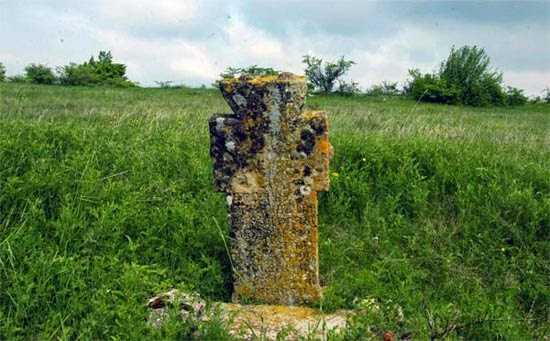
Originally it was thought that the cross marked the center of the circle. But the closer examination showed that the cross stands 15 meters off the center. The stone has an engraving on it which reads „For the glory of Ognjena Marija (Fiery Mary) for the health of people, bountiful harvests and multiplying and health of cattle, this cross erects Rosa with her sons”. The local villagers from the nearest village of Scrobnica told the investigators that Rosa was a very smart and respected woman, so much so that her descendants are still in the area known as Rosići, meaning the descendants of Rosa, even though they have another patrilinear surname. This is extremely rare in Serbia. Rosa was famous for her knowledge of traditional medicine and medicinal herbs. She erected the cross after her house compound caught fire which was successfully extinguished without loss of life. Local people consider the whole complex but particularly the cross dedicated to Ognjena Marija a holy place and regularly visit it and bring offerings to it.
Początkowo sądzono, że krzyż oznaczał środek koła. Ale dokładniejsze badanie wykazało, że krzyż stoi 15 metrów od centrum. Na kamieniu jest wygrawerowany napis: „Na chwałę Ognjenej Mariji (Ogniowej Maryi) dla zdrowia ludzi, obfitych zbiorów, rozmnażania i zdrowia bydła, krzyż ten wznosi Rosa wraz z synami”. Miejscowi wieśniacy z najbliższej wioski Scrobnica powiedzieli śledczym, że Rosa była bardzo inteligentną i szanowaną kobietą, do tego stopnia, że jej potomkowie nadal przebywają w obszarze znanym jako Rosići, co oznacza potomków Rosy, mimo że mają inne patrylinearne nazwisko . Jest to niezwykle rzadkie w Serbii. Rosa słynęła z wiedzy o tradycyjnej medycynie i ziołach leczniczych. Wzniosła krzyż po tym, jak jej dom się zapalił i został pomyślnie ugaszony bez utraty życia. Mieszkańcy uważają cały kompleks, a zwłaszcza krzyż poświęcony Ognjena Marija, za miejsce święte i regularnie go odwiedzają, składając ofiary.
In Slavic mythology, Ognjena Marija or the „Fiery Mary” is considered to be the sister of St Ilija, the thundering sun and (or) wife of the thunder god Perun. She is also known as Perunika, Perena, Ljeljuja, Leluja, Ljelja, Gorka, Veronika. Later, under Christianity, her importance was degraded and she was regarded as an evil goddess, described as an evil and ugly woman named Irudika (who was in turn a daughter of Poganica).
She was the goddess of lightning, weddings, motherhood, and protector of marriage and justice on earth. Perunika wears a rainbow as her belt. In some parts of Croatian people still call rainbow „the mother of god” reffering to Ognjena Marija. Onjena Marija, Perunika uses a heavy sledge hammer to punish people, and controls lightning. Gromovnik (God of Thunder) Perun, helped by his wife Perunika Ognjena Marija, ”loads” the thunderbolts and shoots them at thieves, liars, and immoral people in general.
Była boginią błyskawicy, ślubów, macierzyństwa i obrońcą małżeństwa i sprawiedliwości na ziemi. Perunika nosi tęczowy pas. W niektórych częściach Chorwacji nadal nazywają tęczę „matką boga”, odnosząc się do Ognjena Marija. Ognjena Marija, Perunika używa ciężkiego młota, aby karać ludzi i kontroluje błyskawice. Gromovnik (God of Thunder) Perun, wspomagany przez swoją żonę Perunikę Ognjeną Mariję, „ładuje” pioruny i strzela nimi w złodziei, kłamców i ogólnie niemoralnych ludzi.
In Serbo Croatian flower Iris is also called Perunika, Ljeljuja, Leluja, Ljelja, Sabljarka, Bogiša (bogiša, this name originates from the region around Dubrovnik town, southern Croatia and means God’s flower).
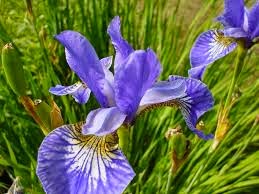
The flower is dedicated to the goddess Perunika. According to a legend, this flower grows at the place where Perun’s spark, lightning, hits the fertile soil. In the same way, a place hit by lightning was considered sacred and objects, like a stone or tree, from such a place were consecrated. This represents a divine sexual act: Perun, the thunder giant, penetrates the earth with his penis (lightning), inseminating the earth with heavenly semen, rain. In Serbian Perunika could mean the place where the seed of perun sprouted. Perunika = Perun + nika = Perun + sprouted.
Kwiat poświęcony jest bogini Perunice. Według legendy kwiat ten rośnie w miejscu, w którym iskra, błyskawica Peruna uderza w żyzną glebę. W ten sam sposób każde miejsce uderzone piorunem zostało uznane za święte, a przedmioty, takie jak kamień lub drzewo, z tego miejsca zostały uświęcone. Jest to boski akt seksualny: Perun, piorun gigant, penetruje ziemię swoim penisem (błyskawicą), zapładniając ziemię nasieniem niebiańskim, deszczem. W języku serbskim Perunika może oznaczać miejsce, w którym wykiełkowało ziarno peruna. Perunika = Perun + nika = Perun + wykiełkowane (wnika i wynika kiełkuje z nicości CB).
Considering that Perunika, Ognjena Marija, is directly linked with fertility of the land, it sounds logical that Perun’s female companion punishes immoral and dishonest women by the ”white plague” (sterility).
In Medjimurje (northern Croatia), one greeting used on the feast day of St. Stephen (Dec. 26) mentions God with lelulja (ljeljuja), i.e. perunika, in his hand. This is the most probable origin of the alternative Perunika’s name Ljelja. But also this could indicate that the true meaning of Perunika is actually lightning, electricity, the spark of life. Perun holding Perunika is Shiva holding Trishula, Lightning.
This Russian „Christian” icon depicts Ognjena Marija or the „Fiery Mary” surrounded with fiery wheels of Perun, inside the burning flame.
Biorąc pod uwagę, że Perunika, Ognjena Marija, jest bezpośrednio związana z żyznością ziemi, brzmi logicznie, że towarzyszka Peruna karze niemoralne i nieuczciwe kobiety „białą plagą” (bezpłodność).
W Medjimurje (północna Chorwacja) jedno z pozdrowień z okazji święta św. Szczepana (26 grudnia) wspomina o Bogu z lelulją (ljeljuja), czyli perunika, w ręku. Jest to najbardziej prawdopodobne pochodzenie alternatywnej nazwy Perunika Ljelja. Ale może to również wskazywać, że prawdziwym znaczeniem Peruniki jest w rzeczywistości błyskawica, elektryczność, iskra życia. Perun trzymający Perunikę to Shiva trzymający Trishulę, Błyskawicę. [I znówe wtrącę swoje trzy grosze etymologicznie – Ljeljuja lub Lelulja lub Ljelja, Leluja – znaczy Lejąca – Lejąca Błyskawicami ale też Lejąca Deszczem – Burza, Nawałnica. Czyżby stąd zasymilowało chrześcijaństwo Aleluja! CB]
Ta rosyjska ikona „chrześcijańska” przedstawia Ognjeną Mariję lub „Świętą Maryję” otoczoną ognistymi kołami Peruna wewnątrz płomienieni ognia.

The fiery wheels of Perun are actually burning sun wheels of Svetovid, the sun god. In South Slavic folk tradition the day of Perun is the 2nd of August, the Crom Dubh day in Ireland. But this day is also the day of St Ilija the Thunderer. St Ilija the Thunderer is Ilios, the thundering sun, the sun at its hottest, the sun that burns with its fiery eye. In Serbian tradition the rolling thunders which can be heard around the 2nd of August are said to be made by the fiery wheels of St Ilia’s chariots thundering over the tops of the clouds, and the lightning that is seen flashing in the clouds are the sparks created by those same fiery chariot wheels.
Ogniste koła Peruna to w rzeczywistości palące się koła słoneczne Svetovida, boga słońca. [CB Najwyższego Boga Światła Świata – Słońa Słońc]
W ludowej tradycji południowosłowiańskiej dniem Peruna jest 2 sierpnia, dzień Crom Dubh w Irlandii. Ale ten dzień jest również dniem św. Ilii Gromowładnego. Święty Ilija Grzmot to Ilios, grzmiące słońce, słońce w najgorętszym okresie słonecznym, słońce płonące ognistym okiem. Zgodnie z serbską tradycją toczące się grzmoty, które można usłyszeć około 2 sierpnia, są wytwarzane przez ogniste koła rydwanów św. Ilii grzmocące nad szczytami chmur, a błyskawice widoczne w chmurach są iskrami stworzonymi przez te same ogniste koła rydwanów.
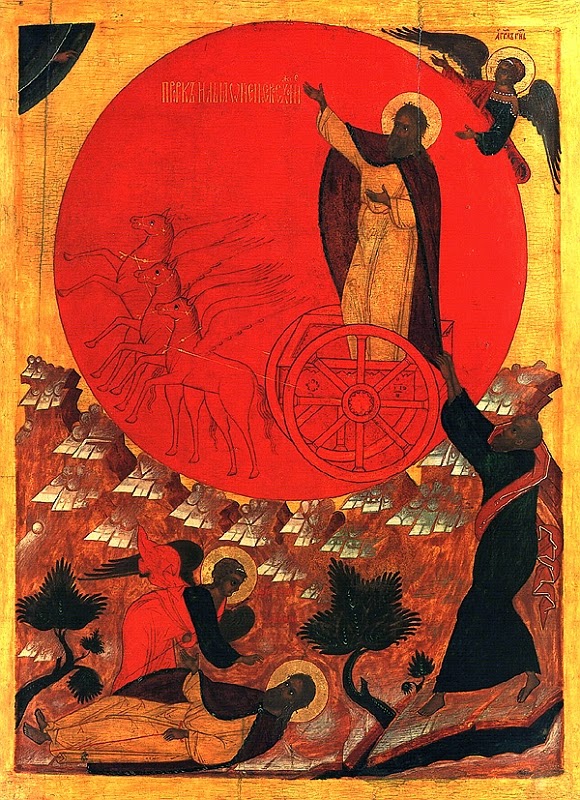
Serbian folk tradition says that if it wasn’t for Ognjena Marija, St Ilija, Perun, Thundering fiery sun would burn the whole world. The the period three days before and the three days after the 2nd of August, the day of the thundering sun, is in South Slavic tradition called Kresovi meaning Fires. These are the dog days, the days of the burning heat when the dog star Sirius is in the sky with the sun. This is also the Irish Domhnach Crom Dubh, the week of Crom Dubh.
In Serbian folk mythology, Ognjena Marija has been transformed into two female christian characters: St Marina, known also as St Margaret and St Mary Magdalene.
30th of July. St Marina, St Margaret, Ognjena Marija
2nd of August. St Ilija the thunderer
4th of August. St Marija Magdalena, Blaga (kind, benign, mild, gentle) Marija
Serbska tradycja ludowa mówi, że gdyby nie Ognjena Marija, St Ilija, Perun, grzmiące ogniste słońce spaliłoby cały świat. Okres trzy dni przed i trzy dni po 2 sierpnia, dniu burzowego słońca, jest w tradycji południowosłowiańskiej zwanej Kresovi, co oznacza Ognie. To są psie dni, dni palącego upału, kiedy psia gwiazda Syriusz jest na niebie ze słońcem. To także irlandzki Domhnach Crom Dubh, tydzień Crom Dubh.
[Oto mamy kolejne potwierdzenie długości trwania świąt u Słowian jako 7 dni: główny jeden dzień oraz trzy przed i trzy po. Stąd chcrześcijaństwo dodało oktawę jako definitywne zamknięcie swoją pieczęcią każdego z rolniczych Świąt Słowian. Opisane tu powyżej święto to Tan Złote Gody – jedno z czterech Świąt Ukośnego Krzyża (od 31 lipca do 6 sierpnia). CB]
W serbskiej mitologii ludowej Ognjena Marija została przekształcona w dwie postacie chrześcijańskie: Świętą Marię (Święta Marina), znaną również jako Święta Małgorzata i Świętą Marię Magdalenę.
30 lipca. Święta Marina, Świąta Małgorzata, Ognjena Marija
2 sierpnia. Święty Ilija Grzmot
4 sierpnia. Święta Maria Magdalena, Blaga Marija (miła, łagodna, łagodna, łagodna) [Błoga, Błogosławiona CB]
You can see that Serbian tradition Kresovi, the week of fire, starts with the fiery Marija and Ends with kind, benign, mild, gentle Marija. In the Irish tradition, Domhnach Crom Dubh used to start on the 31 of July, but now starts on the last Sunday in July. The 2nd of August, Perun day, Crom Dubh day, the day of Ilios the thundering sun, is actually the hottest day of the year in the Balkans. All summer the sun has been burning in the sky. This is the time of wild fires and drought. Everyone is praying for the first big thunderstorms to arrive and save the land from being burnt to cinder. And this is what Ognjena Marija delivers. In Serbia there is a saying: „Od svetog Ilije sunce sve milije” which means „From St Ilija the sun starts getting kinder, milder, gentler”. The first part of the 2nd of August is considered summer and the second is considered to be Autumn. And this is what the transformation of Marija from Ognjena (Fiery) to Blaga (kind, benign, mild, gentle) represents, The end of summer and beginning of autumn.
Widać, że serbska tradycja Kresovi, tygodnia ognia, zaczyna się od ognistej Mariji, a kończy łagodną, błogą, miłą. W tradycji irlandzkiej Domhnach Crom Dubh zaczynał się 31 lipca, ale teraz zaczyna się w ostatnią niedzielę lipca. Dzień 2 sierpnia, dzień Peruna, dzień Crom Dubh, dzień piorunującego/grzmiacego słońca Ilios, jest w rzeczywistości najgorętszym dniem roku na Bałkanach. Przez całe lato słońce paliło się na niebie. To czas dzikich pożarów i suszy. Wszyscy modlą się o przybycie pierwszych wielkich burz i uratowanie ziemi przed spaleniem na popiół. I to właśnie zapewnia Ognjena Marija. W Serbii jest powiedzenie: „Od svetog Ilije sunce sve milije”, co oznacza „Od św. Iliji słońce zaczyna być łagodniejsze, błogie, miłe”. Pierwsza część do 2 sierpnia jest uważana za lato, a druga za jesień. I to właśnie przedstawia przemiana Mariji z Ognjenej (Ogniowej) w Blagę (Błogą, łagodną, miłą), Koniec lata i początek jesieni.
So back to our Bogovo gumno sun circle on mountain Devica and the anthropomorphic cross erected inside of it by a local medicine woman Rosa. Our good old Rosa erected the cross to thank Ognjena Marija, the tamer of fire, for saving her and her family from fire. But why was the cross erected inside the sun circle on Bogovo gumno?
Wróćmy więc do naszego kręgu słonecznego Gumno na górze Devica i antropomorficznego krzyża wzniesionego w nim przez miejscową ląkarkę/zielarkę Rosę. Nasza stara dobra Rosa wzniosła krzyż, aby podziękować Ognjenej Mariji, pogromczyni ognia, za uratowanie jej i jej rodziny przed ogniem. Ale dlaczego wzniesiono krzyż w kręgu słonecznym na Bogovo Gumno?
Being the solar observatory designed to determine, mark, the summer solstice, the big stone circle in Bogovo Gumno was also dedicated to the Sun, also known as Višnji bog (the high god). In Serbian tradition, Sun, the „Višnji Bog”, the High God, is perceived as a living being, which is born every year in the winter. He then grows into a young man Jarilo on the 6th of May the day of the strongest vegetative, reproductive power of the sun. This day marks the beginning of the heating of the world. Then he becomes the powerful ruler Vid at the summer solstice, 21st of June the longest day of the year. He then becomes the terrible warrior Perun on the 2nd of August the hottest day of the year. This day marks the beginning of the cooling of the world.Summer solstice, the day of Svetovid is exactly in the middle of the summer period marked by the day of Jarilo and the day of Perun. Jarilo (heat, fire), Svetovid (light, sun) and Perun (lightning, electricity, energy) are together forming Triglav, Dabog, Hromi Daba the main god of the Serbs. They are also forming Triglav, Crom Dubh, the main god of the Irish. The Thundering Burning Sun, Ilios, Crom Dubh, Hromi Daba, Grom Div is Three in one, Trinity, Trimurti, Agni. He is three in one, as he contains the heat of Jarilo, the light of Svetovid and he adds thunder and lightning. He is the sun at its most powerful and terrifying, the sun that contains the cumulative power of the whole summer.
Będąc obserwatorium słonecznym zaprojektowanym do wyznaczenia, oznaczenia przesilenia letniego, wielki kamienny krąg w Bogovo Gumno był również poświęcony Słońcu, był znany również jako torfowisko Višnji (wielki bóg – Wyszeń CB). Zgodnie z serbską tradycją Słońce, „Bogacz Višnji”, Wielki Bóg, jest postrzegane jako żywa istota, która rodzi się każdego roku zimą. Następnie dorasta do młodego mężczyzny Jaryło 6 maja, w dniu największej wegetatywnej, reprodukcyjnej mocy słońca. Ten dzień oznacza początek ogrzewania świata. Następnie staje się potężnym władcą Videm podczas przesilenia letniego, 21 czerwca, najdłuższego dnia w roku. Następnie staje się okropnym wojownikiem Perunem 2 sierpnia, w najgorętszym dniu w roku. Ten dzień jest początkiem ochłodzenia świata. Przesilenie letnie, dzień Svetovida jest dokładnie w środku lata, wyznaczonego pomiędzy dniami Jaryły i Peruna. Jarilo (ciepło, ogień), Svetovid (światło, słońce) i Perun (błyskawica, elektryczność, energia) tworzą razem Trigława, Daboga, Hromi Daba, głównego boga Serbów. Tworzą także Triglava, Croma Dubha, głównego boga Irlandczyków. Grzmiące Burzliwe Słońce Ilios, Crom Dubh, Hromi Daba, Grom Div jest Trójcą w Jednym: Trinity, Trimurti, Agni. Jest trójcą w jednym, ponieważ zawiera ciepło Jaryły, światło Svetovida i dodaje grzmoty i błyskawice. On jest słońcem w najsilniejszym i najstraszniejszym dniu słońca, które zawiera skumulowaną moc całego lata.
[Jak wiadomo w Księdze Tura także występują Trójce i Czwórce Bogów łączące się i wzmacniające, można o tym przeczytać choćby w Lekcji 3 tu na blogu, i rzeczywiscie w tym Święcie o którym pisze OEC również kumuluje się Trzygłów – Czarnobóg, to są głownie jego dni w Tanie Złotym CB]
Being the wife of Perun, Fiery Sun Ilios, Ognjena Marija is also the wife of the three headed Sun, Dabog, Triglav, Trimurti Agni. So placing her cross inside the Sun circle is very appropriate. What is amazing is that Rosa new the meaning, the importance and the intended use of the Bogovo Gumno sun circle. She didn’t pick the place where she erected the cross within the circle randomly. The cross was erected in such a place and oriented in such a way that when you look directly over it towards the sun circle, you see the point where sun rises on the day of Ognjena Marija, the Fiery Marija, the Wife of the Thundering Fiery Sun, Hromi Daba, Crom Dubh, Grom Div. The Cross marks the day of the beginning of the Kresovi, the fire week, Domhnach Crom Dubh, Lughnasadh.
Now let us have a look at these two Marys who stand on each side of St Ilija.
If we have a look at the hagiography of St Marina also known as St Margaret, who is in Serbia known as Ognjena Marija, the burning, firy Mary, we see some very strange things indeed. According to the version of the story in Golden Legend, she was a native of Antioch, and she was the daughter of a pagan priest named Aedesius. In some sources the name of her father is Theodosius. When she was 15, Olybrius, Governor of the Roman Diocese of the East, asked to marry her but with the price of her renunciation of Christianity. Upon her refusal she was cruelly tortured. During her torture various miraculous incidents occurred.
Będąc żoną Peruna, Ognistym Słońcem Ilios, Ognjena Marija jest także żoną trójgłowego Słońca, Daboga, Triglava, Trimurti Agni. Dlatego umieszczenie jej krzyża w kręgu Słońca jest bardzo właściwe. Zadziwiające jest to, że Rosa jako osoba współczesna znała znaczenie i przeznaczenie koła słonecznego Bogovo Gumno. Nie wybrała miejsca, w którym losowo wzniosła krzyż w kręgu. Krzyż został wzniesiony w takim miejscu i zorientowany w taki sposób, że kiedy patrzysz bezpośrednio nad nim w stronę koła słonecznego, widzisz punkt, w którym słońce wschodzi w dniu Ognjena Marija, Ogniowej Marii, Żony Grzmiącego Ognia Słonecznego, Hromi Daba, Crom Dubh, Grom Div. Krzyż jest dniem rozpoczęcia Kresovi, tygodnia pożaru, Domhnach Crom Dubh, Lughnasadh.
Spójrzmy teraz na te dwie Marie, które stoją po obu stronach św. Iliji.Jeśli spojrzymy na hagiografię św. Mariny znanej również jako św. Małgorzata, która w Serbii znana jest jako Ognjena Marija, burzowa, ogniowa Maryja, widzimy naprawdę bardzo dziwne rzeczy. Według wersji opowiadania w Złotej Legendzie, była rodem z Antiochii i była córką pogańskiego kapłana o imieniu Aedesius. W niektórych źródłach imię jej ojca to Teodozjusz. Kiedy miała 15 lat, Olybrius, gubernator rzymskiej diecezji wschodniej, poprosił ją o rękę, ale za cenę rezygnacji z chrześcijaństwa. Po odmowie była okrutnie torturowana. Podczas jej tortur miały miejsce różne cudowne zdarzenia.
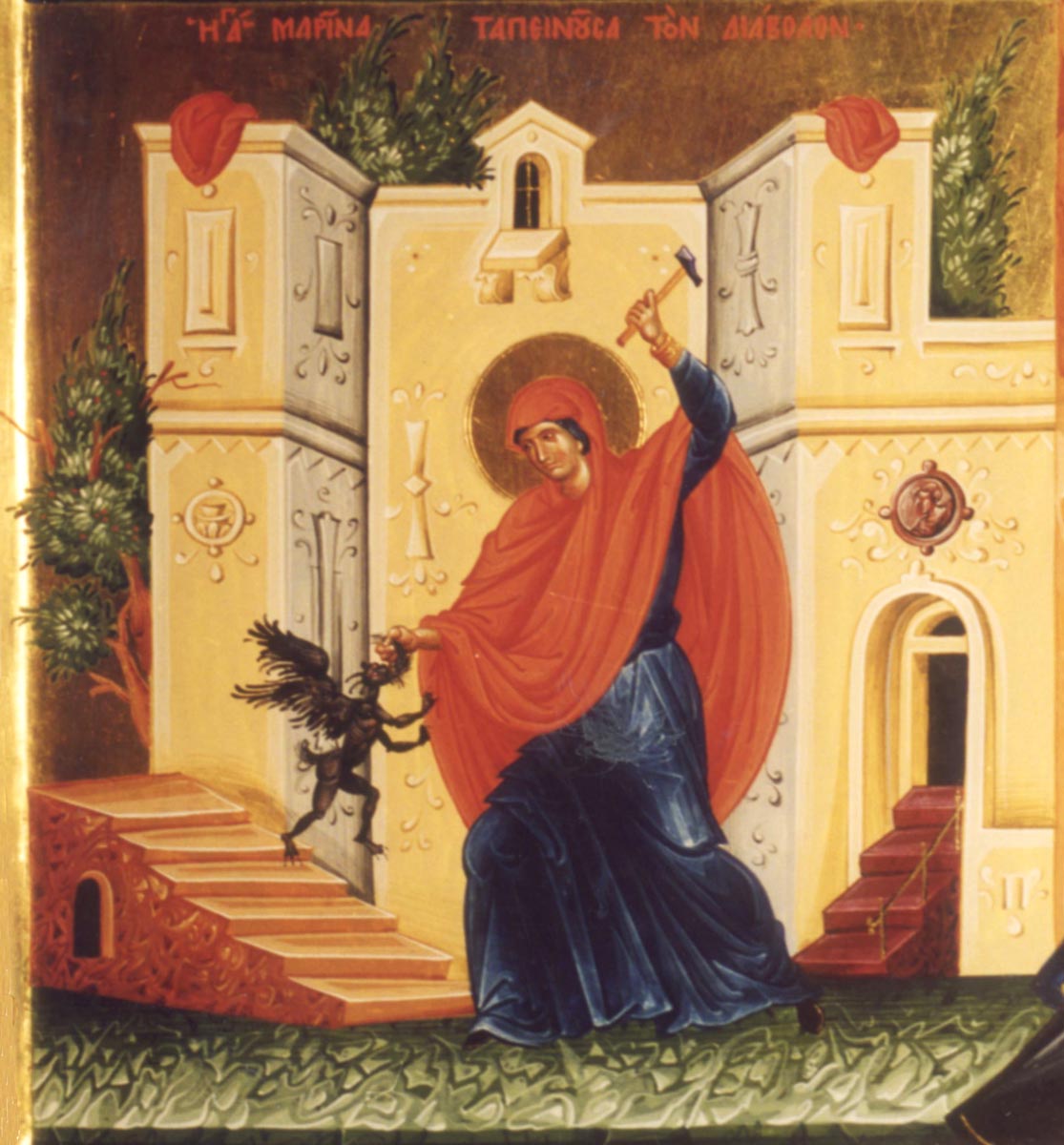
St Marina aka St Margaret uses a hammer, which is with axe, the weapon of Slavic and Germanic thunder gods to defeat a dragon. This makes St Marina aka St Margaret, just a thinly disguised Ognjena Marija, Perunika, the thundering fiery goddess, the wife of a thunder god Perun. Perun defeats Veles who is the dragon.
St Marina (Margaret) is depicted with a red fiery veil to emphasize her true identity: Ognjena Marija, Fiery Mary.
Święta Marina, znana również jako Święta Małgorzata, używa młota, który jest też siekierą, bronią słowiańskich i germańskich bogów piorunów, aby pokonać smoka. To sprawia, że Święta Marina, znana również jako Święta Małgorzata, jest tylko cienko przebraną Ognjeną Mariją, Peruniką, piorunującą boginią, żoną boga piorunów Peruna. Perun pokonuje Velesa, który jest smokiem.
Święta Marina (Małgorzata) jest przedstawiona z czerwoną ognistą woalką, aby podkreślić jej prawdziwą tożsamość: Ognjena Marija, Ogniowa Maryja.
Another miracle occurred when her captors „having beaten her fiercely, fastened the saint with nails to a board and tore at her body with tridents”. But all along she prayed to god. And the Archangel came and healed all her wounds and told her that she will have place in heaven. This is a very interesting story because it too connects St Marina aka St Margaret to a thunder god, but this time to Shiva whose weapon is Trident, Trishula. In my post about Triglav, you could read that in the old Serbian religion, Triglav consisted of Vishnji (Svetovid, Sun), Branjanj (Svarog, fire) and Siva Živa (Perun, thunder and lightning). And St Marina aka St Margaret, for whom Serbian tradition says that she is Ognjena Marija, Perunika, the wife of Perun, was tortured using weapon of Shiva, Živa who is according to Serbian tradition part of Serbian Triglav and the equivalent of Perun. This is the picture of Shiva with his trident, trishula.
Kolejny cud miał miejsce, gdy porywacze „pobili ją gwałtownie, przymocowali świętymi gwoździami do deski i rozdarli jej ciało trójzębami”. Ale przez cały czas modliła się do boga. A Archanioł przyszedł i uleczył wszystkie jej rany i powiedział jej, że będzie miała miejsce w niebie. To bardzo interesująca historia, ponieważ również łączy Świętą Marinę, czyli Świetą Małgorzatę z bogiem piorunów, ale tym razem z Shivą, którego bronią jest Trójząb, Trishula. W moim poście o Triglavie można było przeczytać, że w starej religii serbskiej Triglav składał się z Vishnji (Svetovid, słońce), Branjanj (Svarog, ogień) i Siva Živa (Perun, grzmot i błyskawica). A Święta Marina, znana również jako Święta Małgorzata, dla której serbska tradycja mówi, że jest Ognjeną Mariją, Peruniką, żoną Peruna, była torturowana przy użyciu broni Shivy, Živy, która według tradycji serbskiej jest częścią serbskiego Triglava i odpowiednika Peruna. To jest zdjęcie Shivy z jego trójzębem, trishulą.
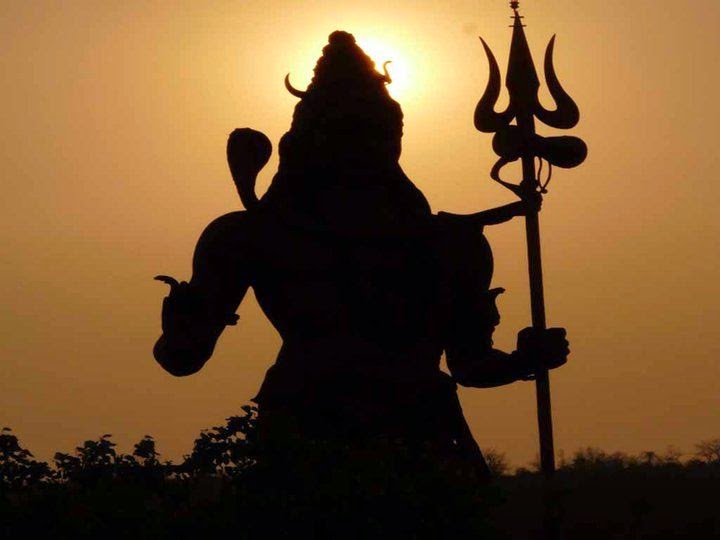
The Angel who comes to heal the wounds of St Marina aka St Margaret, and to promise her a place in heaven, is no other than Archangel Michael, the angel who brandishes a flaming sword, who stands between Heaven and Earth. He is also the dragon slayer just like Perun, and he is the one who controls the rain, fire, thunder, lightning and who punished the wrong-doers exactly like Perun does. Remember that in Medjimurje (northern Croatia), one greeting used on the feast day of St. Stephen (Dec. 26) mentions God with lelulja (ljeljuja), i.e. Perunika, Ognjena Marija in his hand. Also remember that one of the names of Perunika is „sablja” meaning curved sword. Is this a description of Perun, Lightning head of Triglav, and his flaming sword? This is the picture of Archangel Michael killing the dragon.
Anioł, który przychodzi, by leczyć rany św. Mariny, czyli św. Małgorzaty, i obiecać jej miejsce w niebie, jest niczym innym jak Archaniołem Michałem, aniołem, który wymachuje płonącym mieczem, który stoi między Niebem a Ziemią. Jest także pogromcą smoków, podobnie jak Perun, i jest tym, który kontroluje deszcz, ogień, grzmoty, błyskawice i karał złoczyńców dokładnie tak, jak robi to Perun. Pamiętajcie, że w Medjimurje (północna Chorwacja) jedno pozdrowienie zastosowane w święto św. Szczepana (26 grudnia) wspomina o Bogu z lelulją (ljeljują), tj. Peruniką, Ognjeną Mariją w ręku. Pamiętaj też, że jedną z nazw Peruniki jest „sablja”, co oznacza zakrzywiony miecz. Czy to opis Peruna, Błyskawicy głowy Triglava i jego płonącego miecza? To jest zdjęcie Archanioła Michała zabijającego smoka.
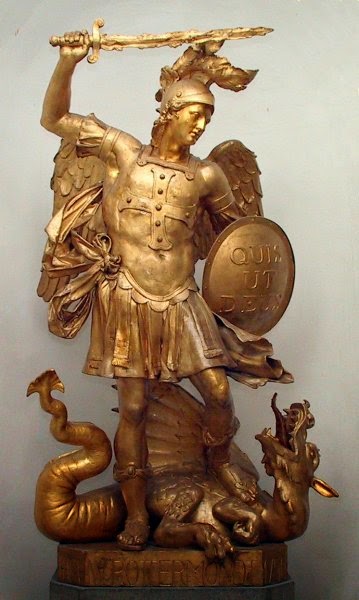
So St Marina aka St Margaret aka Ognjena Marija, aka Perunika the sister of Thundering Sun Ilios and the wife of Thunder god Perun was protected by Archangel Michael who looks very much like Thundering Sun Ilios, Perun. They are both dragon slayers, they both stand between heaven and earth and they both contoll the rain and thunder.
I will have to dedicate a whole separate post to Archangel Michael as I believe that finding out the true identity of Archangel Michael is a key to finding out the identity of God our Lord.
The name of St Marina aka St Margaret is also very interesting. We don’t know what the actual meaning of the name is. Let me propose this etymology.
In Serbian the word „gori” means burns, „goret(i)” means to burn, „goreća” means „burning (feminine)”. Margareta = Mar + goret(ja) = Marija + Goreća = Mary + Burning = Ognjena Marija, Fiery, Burning Mary of Serbian Tradition. This is astonishing. The confirmation that this is indeed true etymology of the name Margaret we find in the German version of the name: Annegret. It is said that it comes from short form of Johanna Margareta. But it could also have this etymology: Annegret = Ann + e + gret = Ona + je + goret(ja) = She + is + burning = Ognjena Marija. The version of the name Greta comes from goret(ja) which literally means „she who is burning”. Is this just a coincidence?
So Ognjena Marija stands on the 30th of July, before Ilios, the thundering fiery sun, stopping him from burning the world to ashes. And she does every year. On the 2nd of August every year the summer ends and autumn begins. The dragon is defeated, the sky opens and the waters of heaven are released on the barren burned earth making it moist and fertile again. The marriage of heaven and earth takes place and at the end of Kresovi, the week of Fire, on the 4th of August, St Marina aka St Margaret aka Ognjena Marija, aka Perunika becomes St Mary Magdalen, Blaga Marija, kind, benign, mild, gentle Marija, the wife of Perun, the wife of the Thundering Sun Ilios. I love that the name of the woman who erected the votive cross in Bogovo Gumno dedicated to Ognjena Marija was Rosa which means dew but also light rain in Serbian. Light rain and dew really do look like tear drops. How appropriate. People who are trying to decode the longest inscription dedicated to Lug, the Galic equivalent of Perun might be intereseted in word „orositi” meaning to sprinkle with water, to irrigate, to water .. 🙂
The „Gospel of Jesus’ Wife” is the name given to a papyrus fragment with writing in Coptic that includes the words, „Jesus said to them, 'my wife…'”. The text on the fragment is alleged to be a fourth-century Coptic translation of what is said to be „a gospel probably written in Greek in the second half of the second century.” So based on this gospel, Jesus was married. To whom?
Mary Magdalen is famous for being a disciple (sister) of Christ the Son (Sun). But also she is famous for washing Christs feet with her tears and drying them with her hair. The gospel of Luke 7:36-50 says:
When one of the Pharisees invited Jesus to have dinner with him, he went to the Pharisee’s house and reclined at the table. A woman in that town who lived a sinful life learned that Jesus was eating at the Pharisee’s house, so she came there with an alabaster jar of perfume. As she stood behind him at his feet weeping, she began to wet his feet with her tears. Then she wiped them with her hair, kissed them and poured perfume on them.
Tak więc St Marina aka St Margaret aka Ognjena Marija, aka Perunika, siostra Grzmiącego Słońca Ilios i żona boga błyskawic Peruna, była chroniona przez Archanioła Michała, który bardzo przypomina Grzmiące Słońce Ilios, Peruna. Obaj są pogromcami smoków, obaje stoją między niebem a ziemią i obaj zwalczają deszcz i grzmoty.
Będę musiał poświęcić cały osobny post Archaniołowi Michałowi, ponieważ uważam, że odkrycie prawdziwej tożsamości Archanioła Michała jest kluczem do ustalenia tożsamości Boga, naszego Pana.
Bardzo interesująca jest także nazwa Świeta Marina, czyli Święta Małgorzata. Nie wiemy, jakie jest znaczenie tego imienia. Pozwólcie, że zaproponuję tę etymologię.
W języku serbskim słowo „gori” oznacza oparzenia, „goret (i)” oznacza palić, „goreća” oznacza „palenie (żeńskie)”. Margareta = Mar + goret (ja) = Marija + Goreća = Mary + płonąca = Ognjena Marija, Ogniowa, Płonąca Maria w serbskiej tradycji. To zadziwiające. Potwierdzenie, że jest to rzeczywiście prawdziwa etymologia imienia Margaret, znajdujemy w niemieckiej wersji imienia: Annegret. Mówi się, że pochodzi od krótkiej formy Johanny Margarety. Ale może również mieć tę etymologię: Annegret = Ann + e + gret = Ona + je + goret (ja) = Ona + pali + Ognjena Marija. Wersja imienia Greta pochodzi od goret (ja), co dosłownie oznacza „ona, która pali”. Czy to tylko zbieg okoliczności?
Tak więc Ognjena Marija stoi 30 lipca przed Iliosem, piorunującym, ognistym słońcem, powstrzymując go przed spaleniem świata na popiół. I robi to każdego roku. 2 sierpnia każdego roku lato się kończy i zaczyna się jesień. Smok zostaje pokonany, niebo się otwiera, a wody nieba uwalniają się na jałową, spaloną ziemię, czyniąc ją ponownie wilgotną i żyzną. Małżeństwo nieba i ziemi ma miejsce, a pod koniec Kresovi, tygodnia ognia, 4 sierpnia St Marina, czyli Margaret, zwana Ognjena Marija, zwana Perunika, zmienia się w Świętą Marię Magdalenę, Blagą Mariję, błogą, łagodną, miłą. Marija, żona Peruna, żona Grzmiącego Słońca Ilios. Uwielbiam to, że imię kobiety, która wzniosła krzyż wotywny w Bogowie Gumno poświęconym Ognjenie Marija, to Rosa, co oznacza w serbskim rosę, ale także lekki deszcz. Lekki deszcz i rosa naprawdę wyglądają jak krople łez. Jak odpowiedni ludzie, którzy próbują rozszyfrować najdłuższy napis poświęcony Lugowi, galijskiemu odpowiednikowi Peruna, muszą być zaintrygowani słowem „orositi”, co oznacza skropienie wodą, nawadnianie, podlewanie… 🙂
„Ewangelia żony Jezusa” to imię nadane fragmentowi papirusu z pismem koptyjskim, które zawiera słowa „Jezus powiedział do nich:„ moja żona … ”. Tekst tego fragmentu jest rzekomo koptyjskim tłumaczeniem z czwartego wieku tego, co mówi się o „ewangelii prawdopodobnie napisanej po grecku w drugiej połowie drugiego wieku”. Opierając się na tej ewangelii, Jezus był żonaty. Z kim?
Maria Magdalena jest znana z tego, że jest uczennicą (siostrą) Chrystusa Syna (Słońca). Ale słynie także z zalania łzami i mycia stóp Chrystusa i osuszenia ich własnymi włosami. Ewangelia Łukasza 7: 36-50 mówi:
Gdy jeden z faryzeuszy zaprosił Jezusa na obiad z nim, poszedł do domu faryzeusza i usiadł przy stole. Kobieta w tym mieście, która prowadziła grzeszne życie, dowiedziała się, że Jezus je w domu faryzeusza, więc przybyła tam z alabastrowym słoikiem perfum. Gdy stała za nim u jego stóp płacząc, zaczęła łzawić na jego stopy. Potem wytarła je włosami, pocałowała je i wylała na nie perfumy.
In villages of Serbia, up until mid 20th century, there was still a wedding custom which required the bride, deva, devojka, devica to wash the grooms feat. In the morning she had to bake a bread to prove that she is able to produce food and feed her children.
Marija Magdalena washes the feat of the Son the Lord with her tears. Remember the Grom Div, the thunder giant, the giant with a sun as a head and lightning as his weapon, flaming sword or spear? Where would his feet be? On earth. Ognjena Marija, Perunika is said to calm the heat of the Sun, the fury of the Sun the Lord. Perun kills the dragon and releases the waters of heaven, rain on earth and brings moisture and fertility to earth.
As we go from the 30th of July to the 4th of August, we see the transformation of Marija. Marija was transformed from Ognjena Marija, Burning Marija, Marija who burns the land to Blaga Marija, Kind Marija, Marija who rains her tears on earth, on the feet of Thundering Sun, Thunder Giant, Grom Div. She is the wife of the Sun the Lord.
But during that time Marija was also transformed from Virgin St Marina aka St Margaret to Harlot St Mary Magdalene. Desire is said to be „burning” and it is burning the most in the bodies of Virgins. In Serbian slang someone who did not have sex for a long time or ever is said to be „zagoreo” meaning to be burnt. It is the spilling of bodily waters that extinguishes this fire.
During the first night, Deva, Devica, (Virgin, Girl) is transformed into Žena (Wife, Woman the giver of Life). What Deva (Virgin, Girl) gives to her Muž (Husband but also Farmer) is her Virginity. In the four Gospels, Mary Magdalene is nearly always distinguished from other women named Mary by adding „the Magdalene” (ἡ Μαγδαληνή) to her name. This has been interpreted to mean „the woman from Magdala”, a town on the western shore of the Sea of Galilee. Luke 8:2 says that she was actually „called Magdalene”. But what if Magdalene comes from Mu + Ga + Dala + Ona = Him + It (Virginity) + Gave + Her = The one who gave her virginity to him, The one who is not a virgin any more, a woman, mother, but also a whore, a harlote, as you can not become a mother without engaging in a sexual act, human or divine. We still say that a girl „gave herself to a man”. Ognjena Marija, Perunika gives herself to Perun, Ilios, she marries Perun, Ilios, the thundering Sun and becomes Blaga marija. Margaret the virgin becomes Mary the woman „Magdalen”. In Serbian bride is called „nevesta”. The word nevesta comes from ne + ve + šta = not + knows + anything = the inocent, the virgin. On her wedding night she gets to „know” her husband, she becomes the one who knows, the one who „ve + šta”, wife. And one of the main duties of a wife is to tend to the fire hearth, the center of the household. Is this where Vesta, the goddess of the hearth comes from? In Serbian word vešt means skillful, full of knowledge and words veštac and veštica mean warlock and witch. Vestal Virgins were specially trained to be skilled in sacred art of fire tending. Is this all also just a coincidence?
In the end I would like to look at the name of the mountain Devica.
In Slavic mythology, Ognjena Marija or the „Fiery Mary” is a goddess who assists, the thunder God Perun. She is the wife (and) or sister of the thunder god Perun. If we know that in Serbian tradition Perun is also Shiva, Živa, then Ognjena Marija, Perunika is Shakti.
Shakti is the concept, or personification, of divine feminine creative power, sometimes referred to as 'The Great Divine Mother’ in Hinduism. She most actively manifests through female embodiment and creativity/fertility, though it is also present in males in its potential, unmanifest form. Not only is Shakti responsible for creation, it is also the agent of all change. Shakti embodies the active feminine energy of Shiva and is identified as Mahadevi or Parvati. The rural people in India believe that Shakti is the protector of the village, the punisher of evil people, the curer of diseases, and the one who gives welfare to the village. So exactly like Ognjena Marija, Perunika in Serbian mythology who punishes the evil people and who gives welfare to the people. The inscription on the votive cross from Bogovo Bumno says: „For the glory of Ognjena Marija (Fiery Mary) for the health of people, bountiful harvests and multiplying and health of cattle…”.
We wsiach w Serbii aż do połowy XX wieku istniał zwyczaj ślubny, który wymagał od panny młodej, devy, devojki, deviki wyczyszczenia wycieraczek. Rano musiała upiec chleb, aby udowodnić, że jest w stanie produkować żywność i karmić swoje dzieci.
Marija Magdalena zmywa łzy Syna Pana. Pamiętasz Grom Div, giganta piorunów, giganta ze słońcem jako głową i błyskawicą jako jego bronią, płonącym mieczem lub włócznią? Gdzie byłyby jego stopy? Na ziemi. Ognjena Marija, Perunika ma uspokoić upał Słońca, wściekłość Słońca Pana. Perun zabija smoka i uwalnia wody z nieba, deszcz na ziemi i przynosi na ziemię wilgoć i płodność.
Przechodząc od 30 lipca do 4 sierpnia, widzimy transformację Mariji. Marija została przekształcona z Ognjena Marija, Ogniowej Mariji, Mariji, która pali ziemię w Błogą Mariję, Łaskawą Mariję, Mariję, która pada na ziemię swoimi łzami, u stóp Gromowego Słońca, Grzmotu Giganta, Grom Div. Jest żoną Słońca Pana.
Ale w tym czasie Marija przekształciła się również z Dziewicy Świętej Mariny (Marii) aka Świętej Małgorzaty w Świętą Nierządnicę Marię Magdalenę. Mówi się, że pożądanie „pali” i najbardziej płonie w ciałach Dziewic. W serbskiej gwarze ktoś, kto nie uprawiał seksu przez długi czas lub kiedykolwiek był uważany za „zagoreo” co oznacza napalonego. Rozlanie wód cielesnych gasi ten ogień.
Pierwszej nocy Deva, Devica (Dziewica, Dziewczę) zostaje przekształcona w Ženę (żona, kobieta dawczyni życia). To, co Deva (Dziewica, Dziewczę) daje swojemu Mužowi (mężowi, ale także gospodarzowi), to jej dziewictwo. W czterech Ewangeliach Maria Magdalena prawie zawsze odróżnia się od innych kobiet o imieniu Maryja, dodając do niej imię „Magdalena” (ἡ Μαγδαληνή). Interpretowano to jako „kobieta z Magdali”, miasta na zachodnim brzegu Morza Galilejskiego. Łukasza 8: 2 mówi, że tak naprawdę została „nazwana Magdaleną”. Ale co jeśli Magdalena pochodzi z Mu + Ga + Dala + Ona = Jemu + Go ( to dziewictwo) + Dała + Ona* = Ta, która dała mu dziewictwo, Ta, która już nie jest dziewicą, kobieta, matka, ale także dziwka, nierządnica, ponieważ nie możesz zostać matką bez udziału w czynności seksualnej, ludzkiej lub boskiej. Nadal mówimy, że dziewczyna „oddała się mężczyźnie”. Ognjena Marija, Perunika oddaje się Perunowi, Iliosowi, poślubia Peruna, Iliosa, grzmiące Słońce i staje się Blaga Marija. Dziewica Margaret zostaje Maryją, kobietą „Magdalen”. W serbskiej narzeczonej nazywa się „nevesta”. Słowo nevesta pochodzi od ne + ve + šta = not + wie + cokolwiek = inocent, dziewica. W noc poślubną „poznaje” swojego męża, staje się tym, który wie, tym, który „ve + šta”, żoną. A jednym z głównych obowiązków żony jest dbanie o palenisko, centrum domu. Czy to stąd pochodzi bogini ogniska Westy? W języku serbskim słowo vešt oznacza zręczne, pełne wiedzy, a słowa veštac i veštica oznaczają czarnoksiężnika i czarownicę. Dziewice westalskie zostały specjalnie wyszkolone, aby umieć posługiwać się świętą sztuką walki z ogniem. Czy to wszystko to tylko zbieg okoliczności?
Na koniec chciałbym spojrzeć na nazwę góry Devica.
W słowiańskiej mitologii Ognjena Marija lub „Ognista Maryja” jest boginią, która pomaga, grzmotliwemu Bogu Perunowi. Jest żoną (i) lub siostrą boga piorunów Peruna. Jeśli wiemy, że w serbskiej tradycji Perun to także Shiva, Živa, a następnie Ognjena Marija, Perunika to Shakti.
[* można również inaczej rozbić to słowo i odczytać jako Maga + Da(na) + Lena, co zonaczałoby Magowi Oddana lub Dana w Lenno, Poświecona Magowi, Sile Mogtycznej/Magicznej Słońca/Światła.
I kolejne zdanie wyutłuszczone przeze mnie powyżej, które potwierdza iż żony bogów u Słowian były ich siostrami jednocześnie – jest to oczywiste w Małżeństwie Pioruna z Błyskawicą, że są oni rodzeństwem. CB]
Shakti to koncepcja lub personifikacja boskiej kobiecej mocy twórczej, czasami określanej w hinduizmie jako „Wielka Boska Matka”. Najaktywniej przejawia się w kobiecym wcieleniu i kreatywności / płodności, chociaż jest również obecna u mężczyzn w swojej potencjalnej, manifestowanej formie. Shakti jest nie tylko odpowiedzialna za stworzenie, ale także jest orędowniczką wszystkich zmian. Shakti ucieleśnia aktywną kobiecą energię Shivy i jest identyfikowana jako Mahadevi lub Parvati. Mieszkańcy Indii wierzą, że Shakti jest obrończynią wioski, pogromcą złych ludzi, uzdrowicielem chorób i tą, która zapewnia wiosce dobrobyt. Dokładnie tak jak Ognjena Marija, Perunika w serbskiej mitologii, która karze złych ludzi i zapewnia ludziom dobrobyt. Napis na krzyżu wotywnym z Bogovo Gumno mówi: „Na chwałę Ognjena Marija (Ognista Maryja) dla zdrowia ludzi, obfitych zbiorów, rozmnażania i zdrowia bydła …”.
The origin of Shakti is goddess Shachi. In Hinduism (specifically, early Vedic accounts), Shachi also known as Indrani (queen of Indra), is the goddess of wrath. She is associated with lions. She has a significance in Vedic lietrature in developing the idea of Shakti which denotes power, the feminine personified might, as described in later Hindu mythology. She gave origin to the concept that female consort, whether she s parvati or kali. She is the role model for all the goddesses in later period. Its is said that unlike other goddesses, she possess an independent character of her own. Unlike most of the goddess wives who are known by their husbands name like Rudrani, Varuni (wife of Varun), Saranya (wife of Sun), Indra is probably the only god who is known to be named after his wife’s name, hence he was often referred as Shachipati – meaning master of shakti/power, or ShachiVat (possessor of Shachi). Indra controls, uses, wields Indrani. In the earlier Vedic accounts, Shachi was depicted as a female shadow of Indra.She is basically his feminine essence, the source of his power, in the same way Shakti is feminine essence and the source of power of Shiva. In the same way Perunika is probably the feminine essence and the source of power of Perun. This fits perfectly with the description of the role of Peruinka as being in the hand of god as his weapon, lightning, flaming sword, flaming spear, flaming trident, vayra. And here is Indrani sitting on a lion, under the tree of life with a child.
Shakti to w oryginale bogini Shachi. W hinduizmie (szczególnie we wczesnych relacjach wedyjskich) Shachi znana jest również jako Indrani (królowa Indry), jest boginią gniewu. Jest związana z lwami. Ma ona znaczenie w wedyjskiej mitologii w rozwijaniu idei Shakti, która oznacza moc, kobiecą personifikację, jaką opisano w późniejszej mitologii hinduskiej. Dała początek koncepcji małżonki bez względu na to, czy jest parvati, czy kali. Jest wzorem do naśladowania dla wszystkich bogiń w późniejszym okresie. Mówi się, że w przeciwieństwie do innych bogiń, posiada ona własny, niezależny charakter. W przeciwieństwie do większości bogiń-żon, które są znane pod imionami swoich mężów, takich jak Rudrani, Varuni (żona Varuny), Saranya (żona Słońca), Indra jest prawdopodobnie jedynym bogiem znanym z imienia swojej żony, stąd był często określany jako Shachipati – znaczy mistrz szakti / mocy lub ShachiVat (posiadacz Shachi). Indra kontroluje, używa, włada Indrani. We wcześniejszych relacjach wedyjskich Shachi była przedstawiana jako żeński cień Indry. Jest ona zasadniczo jego kobiecą esencją, źródłem jego mocy, podobnie jak Shakti jest kobiecą esencją i źródłem mocy Shivy. W ten sam sposób Perunika jest prawdopodobnie kobiecą esencją i źródłem siły Peruna. To doskonale pasuje do opisu roli Peruniki jako będącej w ręku boga, jako jego broni, błyskawicy, płonącego miecza, płonącej włóczni, płonącego trójzębu, vayry. I oto Indrani siedzi na lwie z dzieckiem życia na ręku.
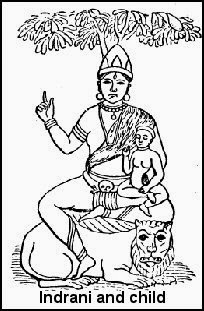
Goddess Shakti, the consort of the thunder god Shiva, Živa, has an incarnation called Durga. She is the terrible war goddess, the goddess of wrath as well. And she too is sitting on a lion.
Bogini Shakti, małżonka boga piorunów Śiwy, Živa, ma inkarnację zwaną Durga. Jest straszną boginią wojenną, a także boginią gniewu. I ona też siedzi na lwie.
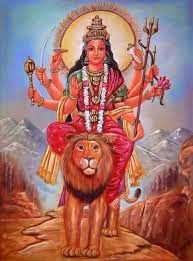
Durga is the original manifested form of Mother Adi – Parashakti, the Great Goddess, Devi herself. She is the goddess of victory of good over evil, exactly like Perunika. She has many weapons and all of them are weapons found used by Thunder gods: trident, scimitar, mace, bow and arrow, spear, sword (longsword), battle-axe, thunderbolt, snake, rod, spade, vajra, hammer weapon, iron weapon, weapon made out of thorns, javelin, dagger. But the two that is wielding most often are trident (vajra) and long blade curved sword. In Serbo Croatian the word for rainbow is „duga”. In some parts of Croatia people call rainbow „Bogorodica” meaning the „mother of god”. Remember that Indrani was the devine mother but also the power of Indra. The name of the mother of God is Marija. So rainbow is Ognjena Marija. Serbian tradition says that Ognjena Marija, Perunika helps Perun to shoot his lightning arrows. In Vedic tradition rainbow was known as „the bow of Indra„. Was the original name of Durga „Duga” meaning rainbow?
Goddess Durga, in her benevolent form is known as Parvati, the consort of Shiva, Živa. Parvati Parvati is considered to be a complete incarnation of Adi Parashakti or Goddess Durga, with all other Goddesses being her incarnations or manifestations. Some communities also believe her to be the sister of Vishnu just like of Ognjena Marija who is the sister of Ilios who is Triglav and therefore Vishnu as well.
Shakti – Durga – Parvati is said to be the source of all the powers and weapons. It is believed that without her, Shiva is Shava or Corpse, for she is the ultimate source of power for all beings, gods and Devas. Remamber that Indrani, the original power goddess was the same. Without her Indra would have no power. So Shakti – Durga – Parvati-Indrani is truly Živa, meaning the alive one in Serbian, the one that gives life and is really Jiva. Indian mythology even says that she is most powerful of all gods. When her anger reaches its peak, she can destroy the whole universe in just seconds. Even Trinity, Trimurty i.e. Brahma, Vishnu and Shiva, never try to make her angry at any cost.
The Durga and Parvati are Ognjena Marija and Blaga Marija. In Sanskrit Durga and Parvati are two opposite faces of the same goddess Shakti. In Serbian they even have the same name with opposite attributes, to indicate that it is one goddess with two faces. They stand on both sides of the thundering sun Ilios, Perun. And Perun day falls on the 2nd of August, the middle of the period when the sun is in the constellation of Leo. This is why Marija, Durga – Parvati – Shakti and Indrani all stand on a lion.
Durga jest oryginalną manifestowaną formą Matki Adi – Parashakti, Wielkiej Bogini, samej Devi. Jest boginią zwycięstwa dobra nad złem, dokładnie tak jak Perunika. Ma wiele broni, a wszystkie z nich są broniami używanymi przez bogów Gromu: trójząb, bułat, buława, łuk i strzała, włócznia, miecz (długi miecz), topór bojowy, piorun, wąż, pręt, szpadel, wadżra, broń młotkowa, broń żelazna, broń cierniowa, oszczep, sztylet. Ale najczęściej dzierżonymi są trójząb (wadżra) i zakrzywiony miecz o długim ostrzu. W języku serbsko-chorwackim słowo tęcza to „duga”. W niektórych częściach Chorwacji ludzie tęczę nazywają „Bogorodica”, co oznacza „matkę Boga”. Pamiętajcie, że Indrani była boską matką, ale także mocą Indry. Imię matki Bożej to Marija. Tęcza to Ognjena Marija. Serbska tradycja mówi, że Ognjena Marija, Perunika pomaga Perunowi strzelać błyskawicami. W tradycji wedyjskiej tęcza była znana jako „łuk Indry”. Czy pierwotna nazwa Durgi „Duga” oznaczała tęczę?
Bogini Durga, w swojej dobroczynnej formie, znana jest jako Parvati, małżonka Śiwy, Żivy. Parvati Parvati jest uważana za pełne wcielenie Adi Parashakti lub Bogini Durgi, przy czym wszystkie inne Boginie są jej wcieleniami lub manifestacjami. Niektóre społeczności również uważają ją za siostrę Wisznu, podobnie jak Ognjena Marija, która jest siostrą Iliosa, który jest Trigławem, a zatem również Wisznu.
Mówi się, że Shakti – Durga – Parvati jest źródłem wszystkich mocy i broni. Uważa się, że bez niej Shiva jest Shava lub Trupem, ponieważ jest ostatecznym źródłem mocy dla wszystkich istot, bogów i dewów. Pamiętajcie, że Indrani, pierwotna bogini mocy, była taka sama. Bez niej Indra nie miałaby mocy. Tak więc Shakti – Durga – Parvati-Indrani to prawdziwie Żiva, co znaczy żywy po serbsku, ten, który daje życie i jest naprawdę Jiva. Indyjska mitologia mówi nawet, że jest najpotężniejsza ze wszystkich bogów. Kiedy jej gniew osiąga szczyt, może zniszczyć cały wszechświat w kilka sekund. Nawet Trójca, Trimurty, tj. Brahma, Wisznu i Śiwa, starają się za wszelka cenę nigdy jej nie rozgniewać. Durga i Parvati to Ognjena Marija i Blaga Marija. W sanskrycie Durga i Parvati to dwie przeciwległe twarze tej samej bogini Shakti. W serbskim mają nawet to samo imię z przeciwnymi atrybutami, co oznacza, że jest to jedna bogini o dwóch twarzach. Stoją po obu stronach piorunującego słońca Ilios, Perun. A dzień Perun przypada 2 sierpnia, w połowie okresu, kiedy słońce znajduje się w gwiazdozbiorze Lwa. Oto dlaczego Marija, Durga – Parvati – Shakti i Indrani stoją na lwie.
| Leo | The Lion | July 23 to August 22 | Fire | Fixed |
Look at these divine couples:
Indra – Indrani
Shiva – Shakti (Živa).
Perun – Perunika
These divine couples are all said to be inseparable. The male can not exist without a female who gives the power to the male. So much so that in the first century CE we find Ardhanarishvara a composite androgynous form of the Hindu god Shiva and his consort Parvati (also known as Devi, Shakti and Uma in this icon). Ardhanarishvara is depicted as half male and half female, split down the middle. The right half is usually the male Shiva, illustrating his traditional attributes. The earliest Ardhanarishvara images are dated to the Kushan period, starting from the first century CE.
Spójrz na te boskie pary:
Indra – Indrani
Shiva – Shakti (Živa).
Perun – Perunika
O tych boskich parach mówi się, że są nierozłączne. Mężczyzna nie może istnieć bez kobiety, która daje moc mężczyznie. Tak bardzo, że w pierwszym wieku n.e. znajdujemy Ardhanarishvarę złożoną androgyniczną formę hinduskiego boga Shivy i jego małżonki Parvati (znanej również jako Devi, Shakti i Uma w tej ikonie). Ardhanarishvara jest przedstawiany jako połowa mężczyzny i połowa kobiety, z podziałem przez środek. Prawa połowa to zazwyczaj mężczyzna Shiva, ilustrujący jego tradycyjne atrybuty. Najwcześniejsze obrazy Ardhanarishvara pochodzą z okresu Kushan, począwszy od pierwszego wieku naszej ery.
[Znamy w naszej słowiańskiej mitologii takie postacie – to wszyscy Bogowie Kiru – dwupłciowi i dwugłowi CB]
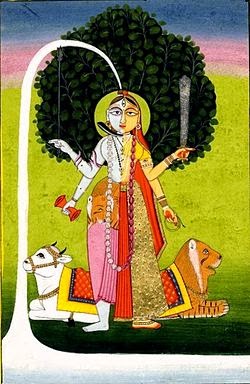
If we think of Earth as female and Sky as male, then lightning would not exist without both Earth and Sky. Life would not exist without both Earth and Sky, without mother and father. This is why the river of life flows from Ardhanarishvara, from the place of connection of Shiva and Shakti. Ardhanarishvara stands at the root of the tree of life because only the union of Male and Female, Sky and Earth produces life.
It is very interesting that in Serbian tradition, Triglav consists of Vishnji, Branjanj and S(h)iva Živa. Does Siva Živa mean Shiva Shakti?
And why is Ardhanarishvara standing between the bull and the lion? Because bull and lion are the beginning and the end of the main vegetative season, Summer.
Jeśli uważamy Ziemię za kobietę, a Niebo za mężczyznę, wówczas błyskawica nie istniałaby bez Ziemi i Nieba. Życie nie istniałoby bez Ziemi i Nieba, bez matki i ojca. Właśnie dlatego rzeka życia płynie z Ardhanarishvary, z miejsca połączenia Shivy i Shakti. Ardhanarishvara stoi u podstaw drzewa życia, ponieważ tylko związek mężczyzny i kobiety, nieba i ziemi produkuje życie.
Bardzo interesujące jest to, że w tradycji serbskiej Triglav składa się z Vishnji, Branjanj i S (h) iva Živa. Czy Siva Živa oznacza Shiva Shakti?
I dlaczego Ardhanarishvara stoi między bykiem a lwem? Ponieważ byk i lew to początek i koniec głównego sezonu wegetacyjnego, Lato.
| Taurus | 21 April – 21 May |
| Leo | 23 July – 22 August |
In Serbian tradition, Sun, the „Višnji Bog”, the High God, the Creator, is perceived as a living being, which is born every year in the winter. He then grows into a young man Jarilo on the 6th of May the day of the strongest vegetative, reproductive power of the sun, the beginning of the Summer, the middle of Taurus, the bull. Then he becomes a fully grown man, the powerful ruler Vid at the summer solstice, 21st of June the longest day of the year. He then becomes the terrible old warrior Perun on the 2nd of August the hottest day of the year, The end of the Summer, the middle of Leo, the lion.
All the above religious system is related to vegetative agricultural cycle. It is extremely important to farmers in continental Europe, but it is almost irrelevant to the steppe nomads, and it is completely wrong in Indian climate which is governed by a monsoon. The hottest month for the western and southern regions of India is April; for most of North India, it is May. So where did this religious system originate? I would suggest Europe. I believe that Vedic Solar Religion was brought to India by farmers from Europe, not by Steppe nomads from central Asia. But that is another story for another time….
So lets go back to the name of mountain Devica.
In Serbian word „deva”, „devica” means Girl, virgin. Deva, Devica Marija is Virgin Mary. Mountain Devica is believed to have been named after Deva Marija, Virgin Mary. But did mountain Devica get its name after Devi Ognjena Marija, Goddess Fiery Marija, Perunika, Shakti (Živa), Indrana, the Great Goddess Devi? Is mountain Devica ancient religious complex dedicated to the Great Goddess, Devi, and if so when was it established and by whom? We might never find this out. But we know that local Serbian people still use this ancient religious complex to celebrate the Great Goddess even today under the name of Ognjena Marija, Perunika.
This posts answered few questions but opened up so many new ones. Looking for answers was and still is a lot of fun.
W tradycji serbskiej słońce, „torfowisko Višnji”, Wielki Bóg, Stwórca, jest postrzegane jako żywa istota, która rodzi się każdego roku zimą. Potem wyrasta na młodego mężczyznę Jaryłę 6 maja, w dniu największej wegetatywnej, reprodukcyjnej mocy słońca, na początku lata, w środku Byka, byka. Potem staje się dorosłym mężczyzną, potężnym władcą Vid podczas przesilenia letniego, 21 czerwca, najdłuższego dnia w roku. Następnie 2 sierpnia staje się okropnym starym wojownikiem Perunem, najgorętszym dniem roku, końcem lata, środkiem Lwa, lwa.
Cały powyższy system religijny związany jest z wegetatywnym cyklem rolnym. Jest to niezwykle ważne dla rolników w Europie kontynentalnej, ale jest prawie nieistotne dla koczowników stepowych i jest całkowicie błędne w indyjskim klimacie rządzonym przez monsun. Najcieplejszym miesiącem dla zachodnich i południowych regionów Indii jest kwiecień; dla większości północnych Indii jest maj. Skąd więc ten system religijny? Sugerowałbym Europę. Uważam, że wedyjska religia słoneczna została sprowadzona do Indii przez rolników z Europy, a nie przez koczowników stepowych z Azji Środkowej. Ale to już inna historia na inny czas ….
Wróćmy więc do nazwy góry Devica.
W serbskim słowie „deva” „devica” oznacza dziewczynę, dziewicę. Deva, Devica Marija to Virgin Mary. Uważa się, że Góra Devica została nazwana na cześć Deva Marija, Virgin Mary. Ale czy góra Devica otrzymała swoją nazwę od Devi Ognjena Marija, Bogini Ogniowej Mariji, Peruniki, Shakti (Živa), Indrany, Wielkiej Bogini Devi? Czy górska Devica to starożytny kompleks religijny poświęcony Wielkiej Bogini Devi, a jeśli tak, to kiedy i przez kogo został założony? Możemy się tego nigdy nie dowiedzieć. Wiemy jednak, że lokalna ludność serbska nadal korzysta z tego starożytnego kompleksu religijnego, aby celebrować Wielką Boginię nawet dziś pod nazwą Ognjena Marija, Perunika.
Ten post odpowiedział na kilka pytań, ale otworzył tak wiele nowych. Szukanie odpowiedzi było i nadal sprawia wiele radości.
